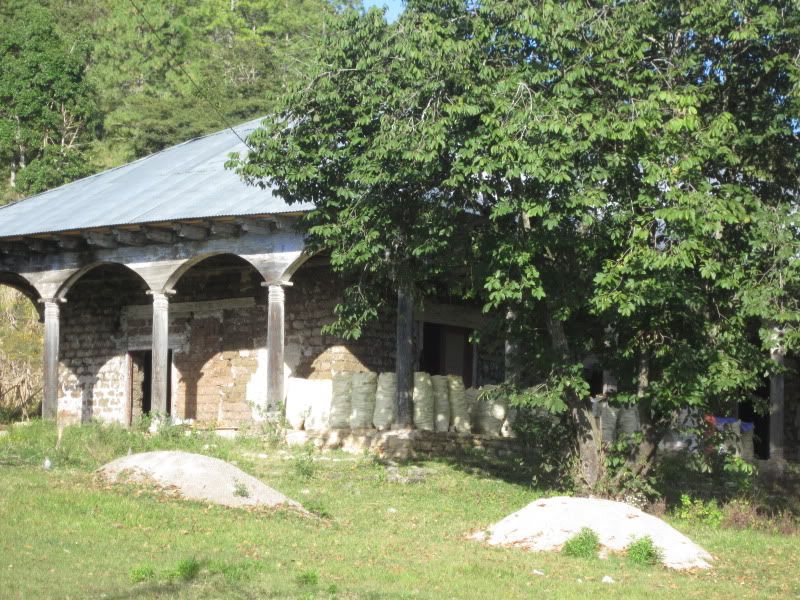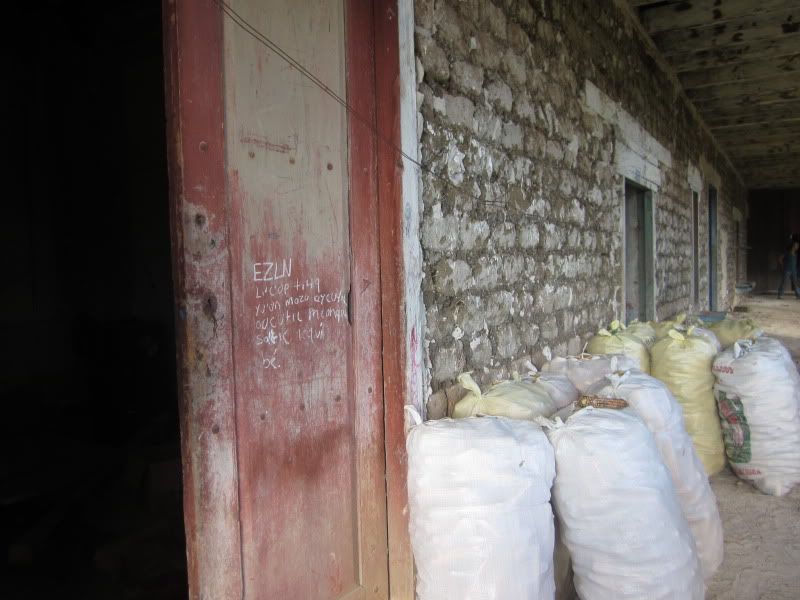(I went with the group Schools for Chiapas, an organization that works with and provides aid to the Zapatistas. Check out their website if you are interested in either traveling with them to Chiapas yourself, or simply buying some artisanal goods or coffee produced by Zapatistas. Aside from the obvious politics involved in supporting Zapatistas, you are supporting human beings who live in extreme poverty and work their asses off to educate themselves and their children and provide for basic needs like water and health care.)
In San Cristobal de las Casas, we crammed all of the luggage and all of the people – seven of us – into Raquel’s car. Three in the front, three in the back, and one with the luggage in the wayback. And off we went for a relatively short drive to Nuevo San Gregorio.
Nuevo San Gregorio, maybe an hour from San Cristobal, was once a hacienda. The owner, who was quite wealthy, was known for treating the indigenous people who worked for him particularly badly. When the revolution came in 1994, the Zapatistas targeted only the most wealthy and most powerful and took their land. They figured that those people were the most likely to be financially okay after their land was taken, and they would also be politically connected enough to be compensated for their losses. This worked out more or less as planned. However, in the confusion of the insurgency, many non-Zapatistas took over land too, and they weren’t as strategic in their targeting of who to take land from. All in all, the Zapatista revolution brought about the largest land reform since the Mexican revolution.
At this particular hacienda, the owner did not hear about the revolution when it happened. He was in his house when some Zapatistas showed up and said, “Permiteme por favor. Necesitas salir. Somos Zapatistas y es nuestra tierra.” (“Pardon me, please. You need to leave. We are Zapatistas and this is our land.”) The owner left at once. Today the land supports several families who farm organically, as well as a Zapatista secondary school that houses and instructs 15 students. The students grow their own food and cook their own food, as well as attending school.
We were warned ahead of time that the road to Nuevo San Gregorio was bad and the car might not be able to make it all the way. We might have to walk, carrying our luggage. Additionally, once we arrived, we might not be able to find the person who had the key to the building where we were to sleep. In other words, this whole trip might be a total bust.
When we got there, the road was better than usual. Raquel’s car could make the trip, but only if the rest of us got out and walked to make the car lighter. Below are some of the photos I took as we walked.

Amaranth. Although most milpa's I've seen have beans, squash, and corn, amaranth is a great fourth addition to the mix.

Does my ass look big in this picture?

Teeny tiny donkeys are sooo cute!

The butterflies here were incredible! We saw tons of butterflies in a zillion different colors.

And... another Coca-Cola advertisement.

Corn, ready to harvest, with tons of flowers growing among it. There were fields and fields like this, full of yellow flowers.

Doesn't look like a typical corn field, does it?

Two pigs and a sheep

A river
We arrived and found Eugenia, an 18-year-old Education Promoter who graduated secondary school at age 12 and has been teaching ever since. She was busy baking bread but she welcomed us and helped us get set up. While someone went to get the key to our room, our group walked over to the Casa Grande (Big House of the hacienda) and checked out the corn harvest, stored in huge 120-pound bags. We had seen people, even women, carrying these bags on their back. I could not even lift one of the bags.

The Casa Grande, with the corn harvest sitting on the patio.

As rich as the hacienda owner was, his Casa Grande was still made from adobe.

A view of the corn harvest on the Casa Grande patio

Another look at the corn harvest and the patio

And another

Casa Grande

"My Little School" - written as graffiti on the Casa Grande just after the 1994 revolution

A room inside the Casa Grande

The students' milpa (cornfield) behind the Casa Grande

The bags of corn

Mexicans grow corn in many colors but all of the corn here is yellow.


Pest-ridden corn set aside for animal feed

A chicken.

A view of the area in front of the Casa Grande. The pillar blocks a basketball hoop, where several students were shooting hoops.

The students' garden, growing peas
Peter and Susan ran off to take care of some business, the others went for a walk, and I sat down to read a book while charging my camera battery in the building that served as the kitchen. There was a light in there, and one small plug. I was going to charge my computer too, but thought better of it, since my computer was of little use without internet and because the electricity might be expensive to the school and I didn’t want to take advantage.

The kitchen, with the baking pans drying outside. This is where they had a lightbulb and one plug, where I charged my camera battery.
Dinner time came, and we had little to eat because we hadn’t been to a market and there were none nearby. We had a few items leftover from Oventic. The Mexicans in our group went to the little store that is run by the school and picked up a few ingredients. For dinner, they made coffee with cinnamon, rice with olive oil and some salt, and sardines. I simply drank coffee and ate rice. No sardines.

The school's store... with a Coke sign.

The room where we stayed
The kids had beans and tortillas for dinner. I spent some time chatting with the boy who was cooking. He was 15 years old and dressed almost as if he were going to church, with nice clothes and clean and combed hair. I wondered how the hell he stayed so clean and well-dressed out here in the countryside when I was going days on end without showering and falling in mud all the time.

The students' dorm
After the members of our group returned, I had an interesting conversation with Rich and Raquel. I brought up a thought I’d had the day before, that Americans go camping to live in rustic environments like this for fun, but they often camp in RVs, or camp with high tech gear bought from REI. Mexicans live the rustic life for real. What would they think if they knew that Americans do it as recreation, and even then bring along equipment to make their camping trips more comfortable and easy?
Rich came back with an even better comment. He brought up reality shows like Survivor. In the rest of the world, peasants have to know how to produce, gather, or hunt and then prepare their own food, construct their own houses, and do everything else to stay alive. In America, we’re so inept at survival skills (because we rarely need them) that we make TV shows out of putting a group of people out in the wilderness and watching them flounder.
It’s pretty surreal, if you think about it.